Have you ever wondered where the ancient and profound teachings of Buddhism first originated? In a world filled with diverse religions and spiritual practices, Buddhism stands out as a philosophy that seeks to uncover the truth about our existence and provide a path to inner peace. But where did it all begin? How did this influential belief system take shape and spread across the globe? Join us on a journey to uncover the birthplace of Buddhism and delve into its fascinating history and origins.
Key Takeaways:
- Buddhism was founded over 2,500 years ago in India by Siddhartha Gautama, also known as the Buddha.
- The path to enlightenment in Buddhism involves morality, meditation, and wisdom.
- Buddhism has different branches, including Theravada, Mahayana, and Tibetan Buddhism.
- Lumbini, in present-day Nepal, is the recognized birthplace of the Buddha and continues to be a significant pilgrimage site.
- Buddhism’s influence has spread across the world, with millions of followers and a growing presence in the West.
The Beliefs of Buddhism
Followers of Buddhism do not acknowledge a supreme god or deity. Instead, their focus is on achieving enlightenment, a state of inner peace and wisdom. The founder of Buddhism, Siddhartha Gautama, also known as the Buddha, is considered an extraordinary being but not a god.
The path to enlightenment in Buddhism involves practicing morality, meditation, and developing wisdom. It is believed that by following this path, one can attain a higher level of consciousness and liberation from suffering. Meditation plays a crucial role in Buddhism, as it cultivates mindfulness and helps individuals gain insight into the true nature of reality.
Buddhism is a tolerant and evolving religion, embracing different philosophies and interpretations. It encourages its followers to find a balance between self-indulgence and self-denial, advocating for a middle path in life. This balance is known as the Middle Way.
One of the foundational teachings of Buddhism is the Four Noble Truths, which form the core of Buddha’s teachings. These truths explain the existence of suffering, its cause, the possibility of its cessation, and the path to achieve liberation from suffering. Understanding and accepting these truths are crucial in one’s journey towards enlightenment.
In addition to the Four Noble Truths, Buddhists also embrace the concepts of karma and reincarnation. Karma refers to the law of cause and effect, asserting that our actions have consequences that shape our future experiences. Reincarnation, on the other hand, emphasizes the belief in the cycle of birth, death, and rebirth, with individuals having multiple lives in different forms.
Buddhism Philosophy: The Three Marks of Existence
In Buddhism, there are three core philosophical concepts known as the Three Marks of Existence. These concepts provide insights into the nature of existence and the human condition:
- Impermanence (Anicca): Everything in the world is in a constant state of change and flux. Nothing is permanent, and clinging to transient experiences or material possessions leads to suffering.
- Suffering (Dukkha): The human experience is characterized by an inherent dissatisfaction and suffering. This suffering arises from attachment and craving, as well as the inability to accept the impermanence of life.
- Non-Self (Anatta): Buddhism rejects the concept of a fixed, independent self. Instead, it teaches that all phenomena are devoid of a permanent, unchanging self. The self is an ever-changing process influenced by various causes and conditions.
These philosophical ideas encourage practitioners to develop wisdom and cultivate detachment from the illusions of a fixed self and the transient nature of existence.
The Buddhism Moral Code: Five Precepts
The moral code in Buddhism is defined by the Five Precepts, which provide guidelines for ethical conduct:
| Precept | Description |
|---|---|
| 1. Do not kill | Refrain from causing harm to any living beings. |
| 2. Do not steal | Avoid taking anything that does not belong to you. |
| 3. Do not engage in sexual misconduct | Show restraint and respect in personal relationships. |
| 4. Do not lie | Speak truthfully and honestly. |
| 5. Do not consume intoxicants | Avoid substances that cloud the mind and impair judgment. |
By following these precepts, Buddhists aim to cultivate compassion, integrity, and mindfulness in their actions, contributing to their own well-being and the well-being of others.

Buddhism Practices
Practicing Buddhism encompasses a range of activities and rituals that aim to cultivate inner peace and enlightenment. These practices can be carried out in temples or in the comfort of your own home. One of the most important practices in Buddhism is meditation, which plays a central role in attaining mindfulness and awakening the truth within oneself.
Buddhist monks, also known as bhikkhus, follow a strict code of conduct that includes celibacy and adherence to moral principles. Their disciplined lifestyle serves as an example for lay followers and provides guidance on living a virtuous life.
While Buddhism does not have specific symbols that represent the religion as a whole, there are several meaningful images that hold symbolic significance within Buddhist teachings. Some of these symbols include:
- The lotus flower: It symbolizes purity and enlightenment, as the lotus grows from muddy waters but remains untainted.
- The dharma wheel: It represents the path to enlightenment and the teaching of Buddha’s dharma.
- The Bodhi tree: It symbolizes the tree under which Siddhartha Gautama attained enlightenment.
- The swastika: In Buddhism, this symbol represents the eternal and unchanging nature of the dharma.
Worship is also a significant aspect of Buddhism, although it is not focused on a higher being or deity. Buddhist worship often involves paying homage to the Buddha, honoring revered monks, and making offerings as acts of devotion and gratitude.

The Founder of Buddhism
Discover the extraordinary life of Siddhartha Gautama, commonly known as the Buddha, who laid the foundation of the profound spiritual tradition of Buddhism. Born into a wealthy family in present-day Nepal around the 5th century B.C., Gautama led a life of luxury and privilege. However, his compassionate nature and deep concern for the suffering in the world drove him to renounce his material wealth and seek a higher truth.
Rejecting the extremes of indulgence and deprivation, Gautama embarked on a relentless quest for enlightenment. After years of searching and practicing asceticism, he realized that neither extreme held the key to liberation. It was through meditation under a Bodhi tree that he finally attained the state of enlightenment, transcending the cycle of birth, suffering, and death.
Gautama, now known as the Buddha, which means the “Enlightened One,” dedicated the rest of his life to sharing his profound teachings with others. He explained the Middle Way, a path that avoids both sensual indulgence and extreme asceticism, as the key to liberation and inner peace. The Buddha’s teachings encompassed the Four Noble Truths and the Eightfold Path, providing guidance for ethical conduct, mental discipline, and the pursuit of wisdom.
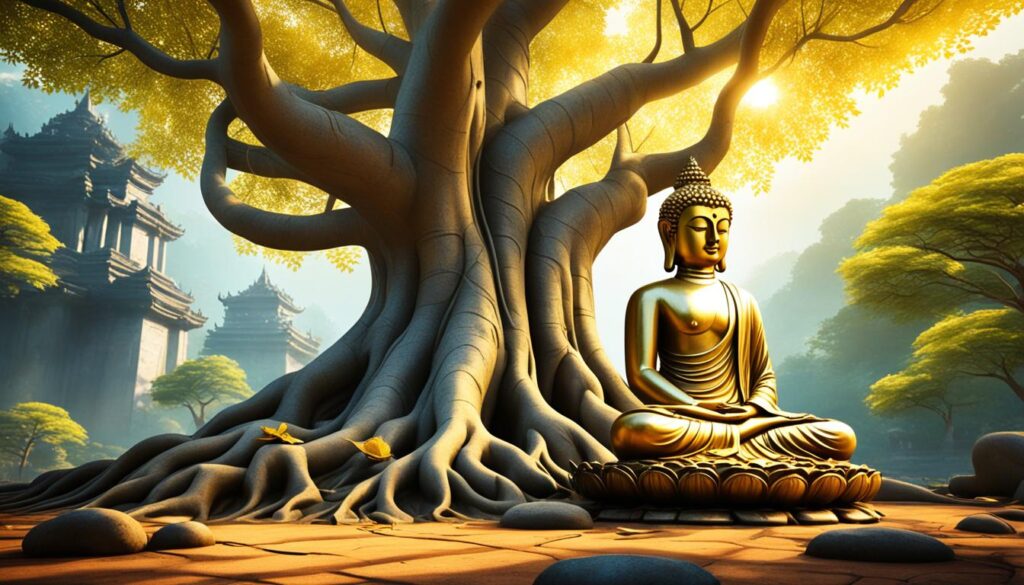
Through his teachings, the Buddha inspired countless individuals throughout history to embark on a spiritual journey of self-discovery and awakening. His message transcends time and resonates with people from diverse backgrounds, offering a path towards overcoming suffering and attaining true happiness.
Spread of Buddhism
In the 3rd century B.C., Ashoka the Great, an Indian emperor from the Maurya Empire, made Buddhism the state religion of India. This pivotal moment in history led to a significant spread of Buddhism beyond its birthplace. Ashoka’s support for Buddhism resulted in the construction of Buddhist monasteries and the encouragement of missionary work, facilitating the expansion of the faith to neighboring regions.
Over the next few centuries, Buddhism gained prominence, particularly in East and Southeast Asia. The teachings of the Buddha resonated with people in these regions, and Buddhist communities flourished. The spread of Buddhism brought about profound cultural and social changes, shaping the spiritual landscape of these areas.
However, the Middle Ages posed challenges for Buddhism, as the rise and spread of Islam introduced a competing religious force. Despite facing difficulties, Buddhism persevered, adapting to new circumstances and finding its way to the West. In recent years, Buddhism has gained popularity and influence in Western societies, where individuals are increasingly drawn to its teachings of mindfulness, compassion, and ethical conduct.

Buddhism in India
In India, the birthplace of Buddhism, the religion flourished for several centuries. The patronage of Ashoka the Great and the construction of Buddhist monasteries created thriving Buddhist communities across the country. However, the subsequent decline of Buddhism in India was driven by various factors, such as political upheavals and the resurgence of Hinduism. Today, Buddhism remains a significant cultural and historical influence in India, particularly in the regions where it originated.
Buddhism in East Asia
In East Asia, countries such as China, Japan, Taiwan, Korea, Singapore, and Vietnam, Buddhism took root and became an integral part of the cultural fabric. Buddhism in East Asia developed distinct characteristics and adaptations, incorporating local customs and beliefs. It played a crucial role in shaping art, architecture, literature, and philosophy in these regions. Today, Buddhism continues to thrive in East Asia, attracting both devout followers and those interested in its teachings.
Buddhism in the West
In the West, Buddhism has gained traction in recent decades, with an increasing number of individuals embracing its principles. The teachings of Buddhism, such as mindfulness, compassion, and non-attachment, resonate with people seeking inner peace and a deeper understanding of themselves. Buddhist meditation practices have gained popularity in Western cultures, where individuals seek solace in a fast-paced and stressful world. Buddhism’s presence in the West continues to grow, with Buddhist centers, retreats, and study groups becoming more prevalent.
| Region | Main Countries |
|---|---|
| India | India, Nepal |
| East Asia | China, Japan, Taiwan, Korea, Singapore, Vietnam |
| The West | United States, Canada, United Kingdom, Australia, Germany, France |
Types of Buddhism
Buddhism encompasses various forms and traditions practiced around the world. These different types of Buddhism offer unique paths and approaches to spiritual practice. Let’s explore some of the main branches of Buddhism:
Theravada Buddhism
Theravada Buddhism, also known as the “Doctrine of the Elders,” is prevalent in Southeast Asian countries such as Thailand, Sri Lanka, Cambodia, Laos, and Burma. It emphasizes the original teachings of the Buddha and the importance of personal meditation practice and monastic discipline.
Mahayana Buddhism
Mahayana Buddhism, the “Great Vehicle,” is widely practiced in East Asian countries including China, Japan, Taiwan, Korea, Singapore, and Vietnam. Mahayana Buddhism places emphasis on compassion, wisdom, and the liberation of all sentient beings. It encompasses various schools and traditions, such as Pure Land Buddhism and Zen Buddhism.
Tibetan Buddhism
Tibetan Buddhism is prevalent in the regions of Tibet, Nepal, Mongolia, Bhutan, and parts of Russia and northern India. It is known for its rich spirituality and integration of indigenous Tibetan beliefs and practices. Tibetan Buddhism places a strong emphasis on meditation, tantric rituals, and the pursuit of enlightenment.
Zen Buddhism
Zen Buddhism, a form of Mahayana Buddhism, is practiced primarily in Japan, China, Korea, and Vietnam. It emphasizes direct insight and experiential wisdom through meditation and mindfulness. Zen practitioners strive to attain enlightenment through direct experience rather than relying on scripture or conceptual understanding.
Nirvana Buddhism
Nirvana Buddhism, closely related to Theravada Buddhism, focuses on achieving the state of pure enlightenment known as nirvana. It places emphasis on liberating oneself from suffering and reaching a state of ultimate peace and happiness.
Each type of Buddhism has its own unique practices, rituals, and interpretations of the Buddha’s teachings. Despite their differences, these traditions share a common goal of achieving liberation from suffering and attaining enlightenment.
Here is a comparison table showcasing some key features of different types of Buddhism:
| Type of Buddhism | Main Regions | Key Emphases |
|---|---|---|
| Theravada Buddhism | Thailand, Sri Lanka, Cambodia, Laos, Burma | Original teachings, meditation, monastic discipline |
| Mahayana Buddhism | China, Japan, Taiwan, Korea, Singapore, Vietnam | Compassion, wisdom, liberation of all beings |
| Tibetan Buddhism | Tibet, Nepal, Mongolia, Bhutan, Russia, northern India | Meditation, tantric rituals, spiritual integration |
| Zen Buddhism | Japan, China, Korea, Vietnam | Direct insight, meditation, mindfulness |
| Nirvana Buddhism | Thailand, Sri Lanka, Cambodia, Laos, Burma | Pure enlightenment, liberation from suffering |
These different paths offer practitioners diverse ways to connect with Buddhist teachings and cultivate wisdom, compassion, and inner peace.

Key Teachings and Concepts in Buddhism
Buddha’s teachings, known as dharma, encompass profound wisdom and ethical principles that guide the lives of Buddhists. These teachings emphasize virtues such as wisdom, kindness, patience, generosity, and compassion, encouraging individuals to cultivate these qualities in their daily lives.
Buddhists adhere to the Five Moral Precepts, which provide a moral code for ethical behavior. These precepts prohibit killing, stealing, sexual misconduct, lying, and the consumption of intoxicants. By following these precepts, Buddhists strive to live a life of integrity and harmony.
The foundation of Buddhist philosophy lies in the Four Noble Truths, expounded by the Buddha. These truths reveal the nature of suffering and offer insights on how to transcend it. They are:
- The truth of suffering: Recognizing the existence and causes of suffering.
- The truth of the causes of suffering: Understanding the origins of suffering, including desire and attachment.
- The truth of the cessation of suffering: Realizing that suffering can be overcome and experiencing liberation from its grasp.
- The truth of the path to the cessation of suffering: Following the Eightfold Path to attain liberation and live a meaningful life.

The Eightfold Path provides a comprehensive guide for ethical conduct, mental discipline, and the cultivation of wisdom. It consists of eight interconnected elements: right understanding, right thought, right speech, right action, right livelihood, right effort, right mindfulness, and right concentration. By following this path, individuals can attain enlightenment and experience true freedom.
Within Buddhism, there are several sacred texts that hold great significance. The Tipitaka, also known as the “Three Baskets,” is a collection of scriptures containing the Buddha’s teachings. It consists of three sections: the Vinaya Pitaka (rules for monastic discipline), the Sutta Pitaka (discourses of the Buddha), and the Abhidhamma Pitaka (analytical and philosophical analysis).
In addition to the Tipitaka, there are various sutras, such as the Diamond Sutra and the Heart Sutra, which expound on specific aspects of Buddhist philosophy. The Book of the Dead, or Bardo Thodol, is a Tibetan Buddhist text that provides guidance for the journey of the soul after death.
| Concept | Definition |
|---|---|
| Dharma | The teachings of the Buddha that guide ethical conduct and spiritual practice. |
| Five Moral Precepts | A set of guidelines that Buddhists follow, prohibiting killing, stealing, sexual misconduct, lying, and the consumption of intoxicants. |
| Four Noble Truths | The fundamental teachings of the Buddha, offering insights into the nature of suffering and a path to liberation. |
| Eightfold Path | A guide for ethical conduct, mental discipline, and the cultivation of wisdom to attain enlightenment. |
| Buddhist Holy Books | Sacred texts such as the Tipitaka, sutras, and the Book of the Dead that contain the teachings and wisdom of Buddhism. |
The Role of the Dalai Lama
The Dalai Lama holds a significant position within Tibetan Buddhism, serving as the spiritual leader and guiding figure for its followers. Considered the reincarnation of previous lamas who have chosen to return to aid humanity, the Dalai Lama embodies wisdom and compassion. Throughout history, there have been 14 Dalai Lamas, each contributing to the religious and cultural development of Tibet.
Traditionally, the Dalai Lama held a prominent role in governing Tibet, providing spiritual guidance and leadership to the Tibetan people. However, following the Chinese occupation of Tibet in 1959, the Dalai Lama and many Tibetans went into exile, establishing a government-in-exile in Dharamshala, India.
The current Dalai Lama, Tenzin Gyatso, was born as Lhamo Thondup in 1935 and was recognized as the 14th Dalai Lama at the age of two. Throughout his life, he has been an advocate for peace, compassion, and the preservation of Tibetan culture. The Dalai Lama’s teachings and lectures have attracted a global following, earning him widespread respect and admiration.
In addition to his spiritual role, the Dalai Lama is a symbol of hope and compassion worldwide. His efforts in promoting peace, human rights, and interfaith dialogue have earned him numerous awards and recognitions, including the Nobel Peace Prize in 1989. The Dalai Lama’s teachings and messages of love and understanding have resonated with people from different walks of life, inspiring individuals to cultivate inner peace and promote harmony in their communities.
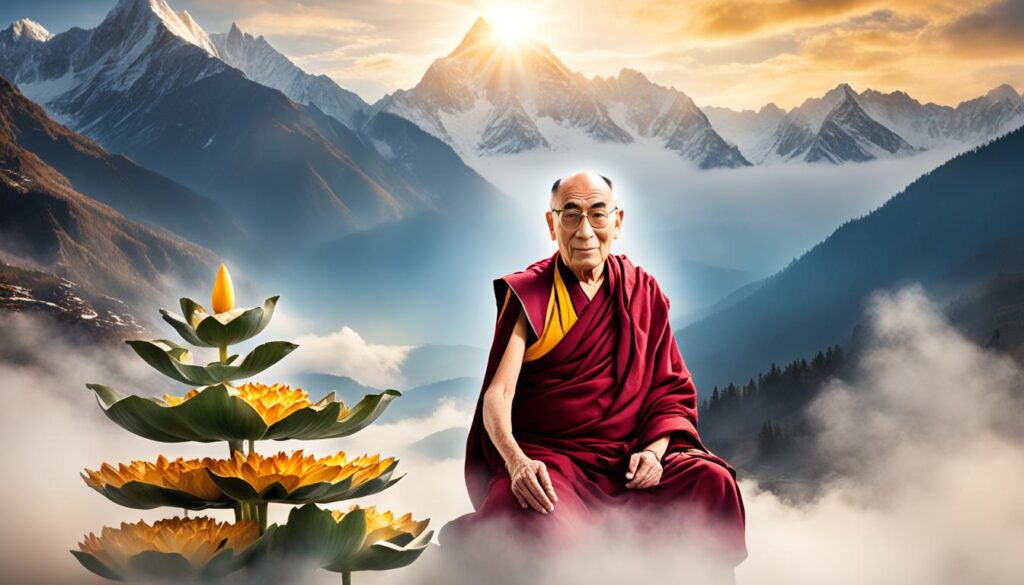
The Dalai Lama’s Influence on Tibetan Buddhism and Beyond
The Dalai Lama’s teachings and leadership have played a vital role in preserving and promoting Tibetan Buddhism around the world. His efforts to revive and propagate Tibetan spiritual traditions have ensured the continuity of this ancient wisdom in the face of adversity.
Beyond the realm of religion, the Dalai Lama’s influence extends to various fields, including psychology, science, and interfaith dialogue. His engagements with renowned scientists and scholars have sparked discussions on the convergence between Buddhism and modern scientific understanding.
The Dalai Lama’s tireless commitment to compassion, peace, and the well-being of humanity serves as a guiding light for individuals seeking spiritual growth and a more harmonious world. His teachings continue to inspire countless individuals, encouraging them to embrace empathy, kindness, and the pursuit of inner peace.
Buddhist Holidays and Festivals
Buddhists celebrate a variety of holidays and festivals throughout the year, each holding special significance in the Buddhist tradition. These celebrations provide opportunities for followers to come together, engage in religious practices, and deepen their spiritual connection. Let’s explore some of the most important Buddhist holidays and festivals:
Vesak
Vesak is one of the most important Buddhist festivals, commemorating the birth, enlightenment, and death of the Buddha. It usually falls on the first full moon day in May. During Vesak, Buddhists engage in acts of generosity, perform meritorious deeds, and visit temples to participate in special ceremonies. The festival is a time of reflection, gratitude, and renewal of commitment to following the path of the Buddha.
Uposatha
Uposatha is a recurring observance that takes place on each quarter of the moon, which usually occurs on the eighth, fifteenth, and twenty-third day of the lunar month. During Uposatha, Buddhists participate in a day of religious discipline and reflection, taking time to reaffirm their commitment to the teachings of the Buddha. It is a time for meditation, recitation of scriptures, and practicing ethical conduct.
Buddhist New Year
The Buddhist New Year is celebrated across different Buddhist communities, often following different lunar calendars. It is a time of joyous celebration, marked by rituals, feasting, and cultural performances. The Buddhist New Year is an opportunity for Buddhists to reflect on the past year, set their intentions for the coming year, and engage in acts of devotion and merit-making.
Other Buddhist Festivals and Celebrations
In addition to Vesak, Uposatha, and the Buddhist New Year, there are numerous other festivals and celebrations observed by Buddhists around the world. These festivals vary across different Buddhist traditions and cultures, but they all serve as occasions for communal gatherings, religious rituals, and cultural expressions. Some examples include Kathina, Asalha Puja, and Pavarana.
These festivals and celebrations play an integral role in the lives of Buddhists, providing them with opportunities to deepen their understanding of the Dharma, strengthen their connection with the Buddhist community, and cultivate virtues such as compassion, generosity, and mindfulness.
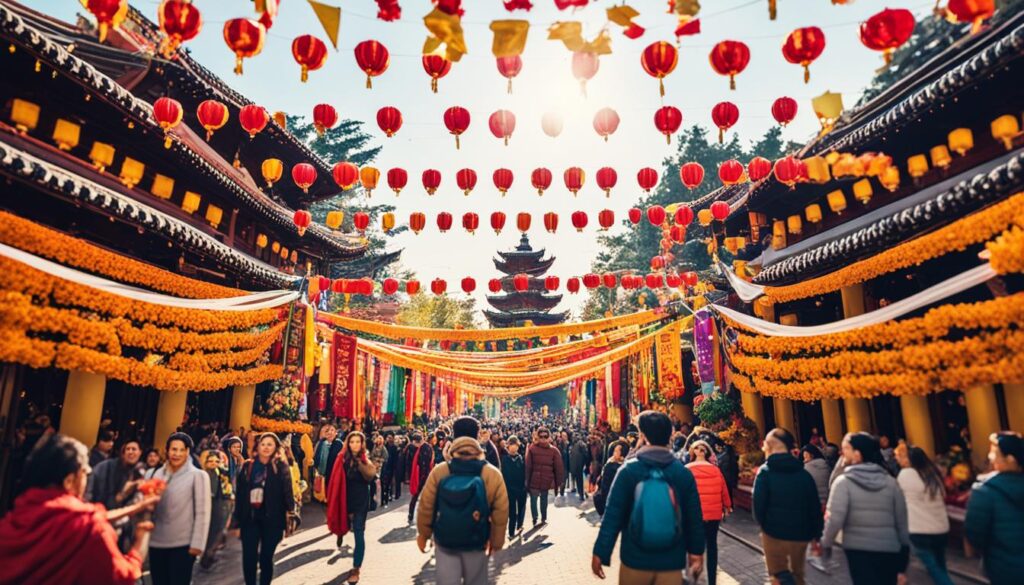
An illustration representing the joyous celebration of Buddhist festivals and the unity of the Buddhist community.
The Birthplace of the Buddha: Lumbini
Step into the sacred gardens of Lumbini, Nepal, and you will find yourself standing at the birthplace of Siddhartha Gautama, the Buddha. It was here, in the year 623 B.C., that the enlightened one took his first breath and began his journey to spiritual awakening.
Lumbini has transformed into a revered pilgrimage site, drawing devotees from around the world who seek to pay homage to the birthplace of the Buddha. The site is adorned with archaeological remains that serve as a testament to the historical significance and spiritual heritage of this sacred place.
One of the notable attractions in Lumbini is the Maya Devi Temple. Here, visitors can witness the remains of ancient brick structures dating back to the 3rd century BC, offering a glimpse into the ancient history and culture associated with the birth of the Buddha.
As the birthplace of the Buddha, Lumbini holds immense importance in Buddhism. It serves as a beacon for followers of this ancient philosophy and provides an opportunity for spiritual connection and reflection. The pilgrimage to Lumbini allows devotees to immerse themselves in the profound teachings and enlightened path of the Buddha.
Efforts are underway to develop Lumbini as a renowned Buddhist pilgrimage center, inviting seekers of truth and enlightenment to walk in the footsteps of the Buddha. The serene beauty, archaeological remnants, and spiritual ambiance of Lumbini make it a destination of profound significance for Buddhists and spiritual seekers alike.
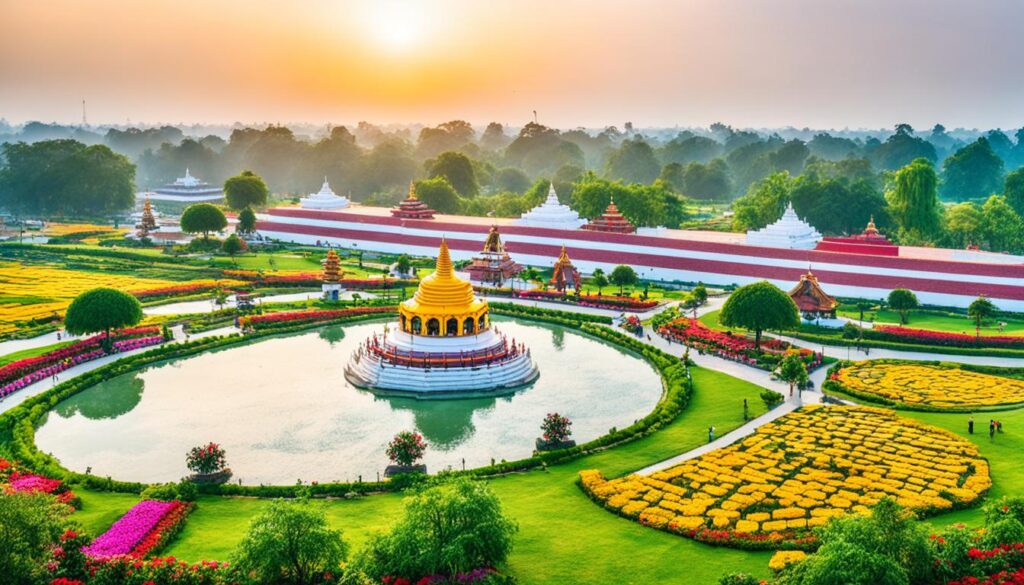
Lumbini At a Glance:
| Location | Archaeological Remains | Significance |
|---|---|---|
| Lumbini, Nepal | Ancient brick structures | Birthplace of the Buddha |
| Maya Devi Temple | Sacred pilgrimage site | |
| Development as a Buddhist pilgrimage center |
Importance of Lumbini in Buddhism
Lumbini holds immense significance for Buddhists as it is the birthplace of the Buddha. As a Buddhist pilgrimage center, it attracts followers from around the world who come to pay their respects and connect with the roots of their faith.
The site is marked by the iconic Asoka pillar, erected by the Indian emperor Ashoka in 249 BC, as a commemorative monument. This ancient pillar stands as a symbol of reverence and serves as a reminder of the rich Buddhist history associated with Lumbini.
Lumbini is managed and preserved by the Lumbini Development Trust, a dedicated organization committed to maintaining the sanctity and heritage of this sacred site. The Trust ensures that Lumbini remains accessible to visitors and provides resources for the study and exploration of Buddhist history and culture.
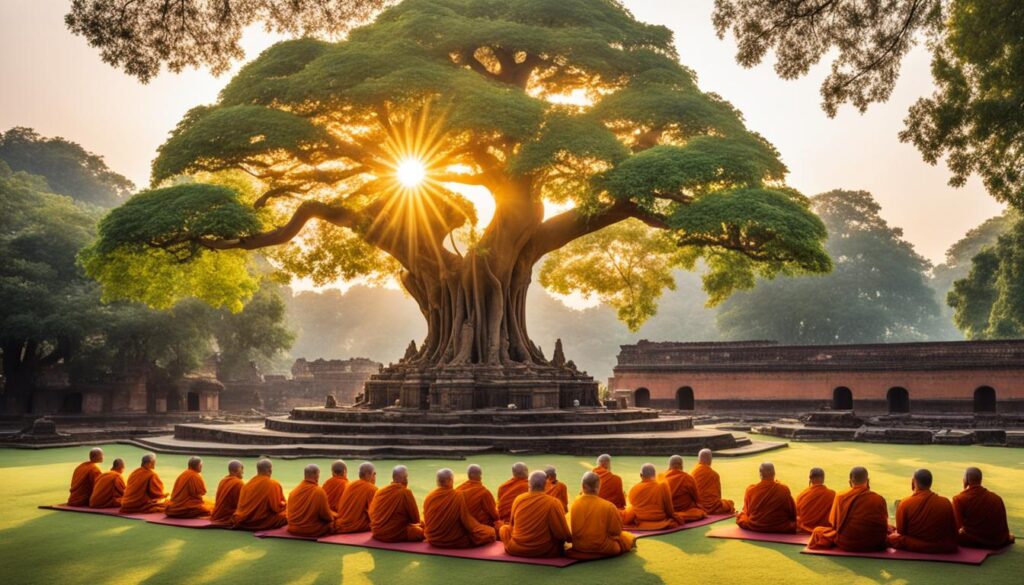
Table 11.1: Significance of Lumbini
| Key Points | Explanation |
|---|---|
| Pilgrimage Center | Lumbini is a renowned pilgrimage center where Buddhists from all over the world come to seek spiritual solace and connect with the Buddha’s teachings. |
| Asoka Pillar | The Asoka pillar stands as a significant landmark, symbolizing the profound historical and cultural importance of Lumbini in Buddhist tradition. |
| Buddhist History | Lumbini holds a pivotal place in Buddhist history as the birthplace of the Buddha, serving as a beacon of enlightenment and inspiration. |
| Buddhist Heritage | The preservation and conservation efforts by the Lumbini Development Trust safeguard the rich Buddhist heritage associated with the site. |
| Development Trust | The Lumbini Development Trust plays a crucial role in managing and maintaining the site, ensuring its sanctity and accessibility for future generations. |
Lumbini offers a unique opportunity for Buddhists and enthusiasts alike to deepen their understanding of Buddhist history, engage with its spiritual essence, and embark on a transformative journey of self-discovery. It stands as a testament to the enduring legacy of Buddhism and its relevance in the modern world.
Protection and Conservation of Lumbini
Lumbini, the birthplace of the Buddha, is not only a sacred site for Buddhists but also an important archaeological treasure. In order to preserve its historical and cultural significance, Lumbini is protected under the Ancient Monument Preservation Act of 1956. This act ensures that the site is safeguarded for future generations and its integrity remains intact.
The responsibility for the management and conservation of Lumbini lies with the Lumbini Development Trust, an autonomous organization dedicated to the preservation and promotion of this revered pilgrimage site. The trust works closely with the government of Nepal, which owns the entire property, to ensure the protection and maintenance of Lumbini’s archaeological remains.
To provide an added layer of protection, Lumbini has a designated buffer zone surrounding the main site. This buffer zone serves as a protective barrier against encroachment and inappropriate development. It helps maintain the sanctity of the area and prevents any potential threats to the site’s archaeological value.
Preserving the integrity of Lumbini requires constant conservation efforts and monitoring of its archaeological remains. The Lumbini Development Trust, with the support of archaeologists and experts, undertakes regular maintenance and restoration projects to safeguard the historical structures and artifacts found within the site.
However, protecting Lumbini comes with its own set of challenges. One of the significant challenges is managing the impact of visitors while maintaining a delicate balance between conservation and tourism. Striking this balance ensures that the site can be accessed and appreciated by pilgrims and tourists while safeguarding its historical significance.
In addition to visitor management, Lumbini also faces potential threats from industrial development in the region. The growing industrialization and commercialization in the vicinity of the site pose risks to its tranquility and preservation. It is crucial to address these threats and implement sustainable development practices that are sensitive to the site’s historical and cultural importance.
The protection and conservation of Lumbini require a collaborative effort between the Lumbini Development Trust, the government of Nepal, and various stakeholders. By ensuring the preservation of this ancient pilgrimage site, we can continue to honor the birthplace of the Buddha and appreciate its rich historical and spiritual heritage.
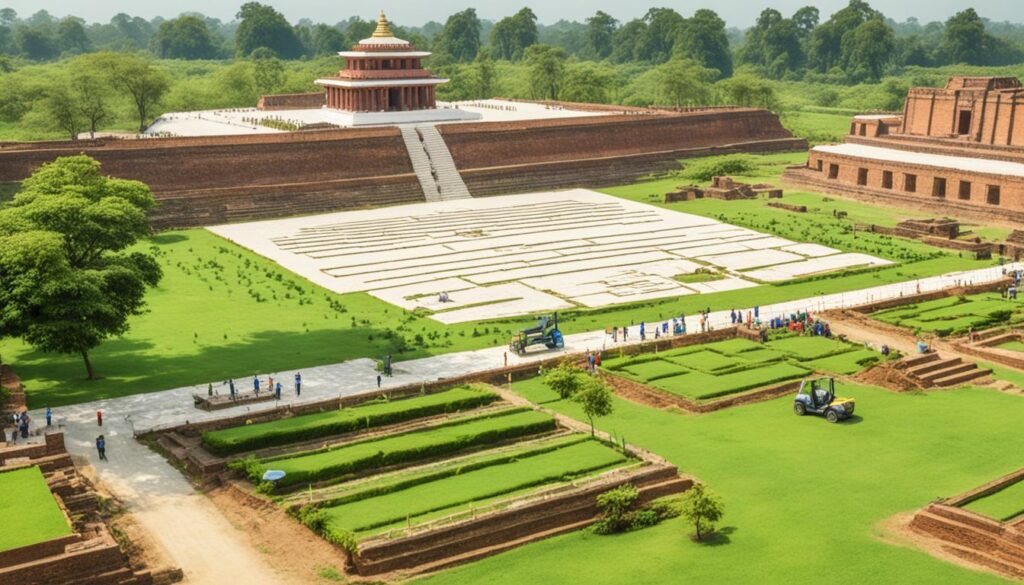
Buddhism’s Impact and Relevance Today
Buddhism’s teachings and practices have had a profound impact on individuals and society. In modern society, the principles of Buddhism offer valuable insights into addressing the challenges of daily life and promoting societal harmony.
One of the key aspects embraced by Buddhism is mindfulness. The practice of mindfulness involves being fully present in the moment, cultivating awareness of one’s thoughts and emotions without judgment. Mindfulness has gained significant recognition in recent years for its positive impact on mental well-being and stress reduction. Incorporating mindfulness into daily life can enhance focus, clarity, and overall emotional resilience.
Compassion is another essential concept in Buddhism. It is the capacity to empathize with the suffering of others and to take action to alleviate that suffering. By cultivating compassion, individuals can develop deeper connections with others, enhance their relationships, and contribute to the overall well-being of society.
In the modern world, where stress, anxiety, and divisiveness are prevalent, the teachings of Buddhism provide a path towards inner peace and societal harmony. Buddhism emphasizes non-violence, ethical conduct, and respect for all living beings. These principles serve as a guiding compass for individuals to navigate their interactions with others and contribute positively to their communities.
By integrating the practice of Buddhism into their lives, individuals can find practical guidance for leading a balanced and meaningful existence. Buddhism’s emphasis on self-awareness, mindfulness, compassion, and ethical behavior can bring about personal transformation, fostering a sense of inner harmony and a deeper connection with the world.

Conclusion
Buddhism’s global reach is a testament to its enduring appeal and relevance in today’s world. Originating in India over 2,500 years ago, Buddhism has spread to every corner of the globe, attracting millions of followers who seek enlightenment and inner peace.
At the heart of Buddhist philosophy is the belief in compassion, mindfulness, and ethical conduct. These principles offer valuable guidance for navigating the challenges of the modern world, promoting personal well-being and societal harmony.
As a vibrant and evolving tradition, Buddhism encourages individuals to lead noble and fulfilling lives. Its teachings inspire us to cultivate wisdom, practice meditation, and strive for enlightenment.
Whether in the serene temples of East Asia, the bustling streets of Southeast Asia, or the meditation halls of the West, Buddhism continues to inspire and transform lives. Its universal message of compassion and mindfulness resonates with people from diverse backgrounds, making it a truly global philosophy.
FAQ
Where was Buddhism founded?
Buddhism was founded by Siddhartha Gautama, also known as “the Buddha,” over 2,500 years ago in India.
What are the beliefs of Buddhism?
Buddhism focuses on achieving enlightenment and inner peace. Followers do not worship a supreme god but strive for wisdom and moral conduct.
How do Buddhists practice their faith?
Buddhists practice through meditation, moral conduct, and learning. They can practice at home or in temples, and some become monks or nuns.
Who was the founder of Buddhism?
Siddhartha Gautama, also known as the Buddha, is considered the founder of Buddhism.
How did Buddhism spread from its place of origin?
Buddhism spread from India to other parts of Asia, including East and Southeast Asia. It is now growing in influence in the West as well.
What are the different types of Buddhism?
There are various types of Buddhism, including Theravada, Mahayana, Tibetan, Zen, and Nirvana Buddhism, each with its own traditions and beliefs.
What are the key teachings and concepts in Buddhism?
Buddhism emphasizes concepts such as the Four Noble Truths, the Eightfold Path, and the practice of mindfulness. The teachings are found in sacred texts like the Tipitaka and sutras.
What is the role of the Dalai Lama in Buddhism?
The Dalai Lama, who is the spiritual leader of Tibetan Buddhism, is highly respected and considered the reincarnation of past lamas. The current Dalai Lama is Lhamo Thondup.
What are some important Buddhist holidays and festivals?
Vesak, Uposatha, and the Buddhist New Year are significant festivals in Buddhism, celebrated by followers worldwide with rituals, offerings, and religious ceremonies.
Where is the birthplace of the Buddha?
The birthplace of the Buddha is Lumbini, located in present-day Nepal.
What is the significance of Lumbini in Buddhism?
Lumbini is a pilgrimage center and an important place for studying Buddhist history and heritage. It is marked by the Asoka pillar and is considered a sacred site for Buddhists.
How is Lumbini protected and conserved?
Lumbini is protected under the Ancient Monument Preservation Act and managed by the Lumbini Development Trust. The conservation of archaeological remains and addressing potential threats are important aspects of its preservation.
What impact does Buddhism have in today’s world?
Buddhism’s teachings continue to inspire individuals to seek enlightenment, inner peace, and wisdom. Its principles of compassion, mindfulness, and ethical conduct resonate with many people globally.
Can Buddhism be practiced by anyone?
Yes, Buddhism is open to anyone who wishes to follow its teachings and adopt its practices. It is a tolerant and inclusive religion.

